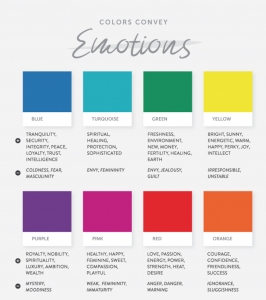By Colleen Martin, Principal
It was March 13th. Friday, the 13th, to be exact. We were working from home and our bosses told us to stay safe, and that they would see us back at the office in two weeks. Two weeks became four weeks, and so on and so on; we have not been back to working in the office since that day.
That was the day I realized the coronavirus pandemic was upon us – and just like that, our everyday activities and daily routines would rapidly change.
As the COVID-19 pandemic spread throughout the world, in the United States alone, over 36,000 journalists lost their jobs, were furloughed, or had their pay cut, according to data from the New York Times. As advertising budgets were slashed by businesses affected by the pandemic, newsrooms such as Fortune, Quartz, the LA Times, and many more that relied heavily on advertising dollars were forced to make decisions that no one ever wants to make. Managers had to lay off or reduce their editorial staff — the vibrant, hard-working, and badly needed writers we all depend on to keep us informed about what’s happening in the world.
At the same time, the PR industry was no more immune to the financial impact of the pandemic. According to a PRWeek poll of the industry in May 2020, one in five agencies laid off staff and instigated furloughs; 77% of clients reduced PR retainers and 90% postponed PR campaigns.
No doubt about it, the past year has been hard. It has forced us to figure out new ways to do things — conferences became virtual events and business travel became Zoom meetings. For PR folks, it forced us to be creative in the way we contacted and communicated with journalists.
Journalists have long had a complicated relationship with PR professionals, and vice versa. Some might liken it to unrequited love (PR chasing the journalists). U.S. Census data shows that PR pros now outnumber journalists 6-to-1, as newsrooms shrink and demand for public relations grows. This means that reporters, especially ones at the most influential media outlets, are often bombarded with emails by PR folks, sending them story ideas on behalf of their clients. Before the pandemic, this was typically combined with (much hated) phone calls to their offices.
Many of the traditional ways of doing our jobs had to change once we closed our doors and started calling our homes our offices. Unless we are contacting a journalist where we already have an existing relationship, most of us don’t have each other’s personal cell phone numbers. With inboxes being flooded with hundreds of story pitches, we had to be smarter and more selective about the way we communicate potential good story ideas with reporters.
In some cases, Twitter DMs (direct messages) quickly became a smart and convenient way to send a quick, private message to a journalist to start a one-on-one conversation – a line or two about who you are and what you want to chat about, which could spur a desire to have a conversation offline to learn more. Those journalists know that by having their DMs open, that they are inviting this type of inbound communication, and it gives those of us in PR a sort of “green light” to send short, targeted and relevant messages to reporters. And those that do not want to be communicated with this way have a simple solution – to keep their DMs closed.
Many journalists when working on a deadline often send out a tweet with a quick question looking for a subject matter expert or other source that can quickly answer a question for a story they are working on. By following the appropriate writers on Twitter and keeping up to date with what they are talking about on social media, not only will you get to know their interests better, but you will also be able to tap into those opportunities that are all about seeing the right tweet at the right time, and getting them the right source exactly when they need it – a win for them, and a win for you and your client.
LinkedIn has been another channel that has been helpful to me and my colleagues to build trust and dialogue with journalists. There are over 260 million monthly active users on LinkedIn, and while you may need to pay for LinkedIn Premium to get InMail capabilities (where you can directly message another LinkedIn member that you’re not connected to), there are plenty of ways to leverage LinkedIn to connect with journalists without paying for this service. Once you know a writer’s email address, and you have connected with them by phone or email, you can request to add them to your network, and send a quick message with your connection request. There is no need for a long, drawn out email, and LinkedIn is not the place for your four-paragraph story pitch. LinkedIn is a great way to connect, engage with and follow what writers are talking about in their LinkedIn feed – and to serve as a dependable resource for them when the right time comes.
There is a time and a place for every communication method, and it’s super important to not be tone deaf when it comes to pitching the media. Use common sense, have empathy, consider journalists’ time and expertise, and consider the current weeks’ events before reaching out. Be a reliable source, and you’ll quickly become reporters’ go-to trusted PR person when it comes to getting what they need to tell a good story. The pandemic has taught us that whether you work as a PR professional or a journalist, that we are all just human beings doing our jobs.
As Bruce Lee said: “Knowledge will give you power, but character, respect!”
How Brand Messaging Gives Your Business AuthorityA book review of Donald Miller’s, “Building a StoryBrand: Clarify Your Message So Customers Will Listen.”
By Victor Filoromo, Strategist
“Pretty websites don’t sell things. Words sell things.” It’s one of the opening sentences in Donald Miller’s book Building a StoryBrand. Every day, according to Miller, brands are making mistakes that cost them customers, attention, and most importantly, cash.
Think of your favorite big-budget box office hit. You may be drawn in by special effects or the unique soundtrack, but ultimately, there’s a story that hooks you for two hours. When it comes to your brand, it’s important that your story sells and your marketing dollars are well spent.
Positioning Your Business for Success
In his book, Miller discusses the top two reasons businesses fail when it comes to marketing: they don’t focus on what helps people survive and thrive and they force customers to waste valuable time understanding what they offer.
If you aren’t helping someone survive and thrive, your message falls flat. Likewise, when the message is muddled, customers don’t know what their next steps should be and look elsewhere.
Experienced writers know that great writing often isn’t about what is said, but what is left unsaid — eliminating clutter. When it comes to marketing your business, it’s all about creating an effective story that informs. So, how exactly should that be done?
The Customer Is the Hero
Once you have determined who your ideal customers are, you need to understand what they are looking for and how to help them get there. Customers don’t necessarily want to hear about long personal histories, or how your grandfather’s business dealings in the 1920s led to where the company is today. That may come later, but initially, they have a problem to solve. As Miller says throughout the book, keep in mind that your brand is not the hero in the story, the customer is.
Does Your Story Answer the Right Questions?
Within a few seconds of visiting a website, a customer should be able to answer three important questions: What do you offer? How will it make my life easier? What do I need to do to buy it? Every year, companies close their doors not because their product is bad, but because customers don’t know how that product will make their life better. In this day and age, competition comes from everywhere, and attention spans are short. You only have a few seconds to make an impact before someone clicks away to another website.
As Miller points out in the book, customers seek to solve three problems.
- External: A physical barrier that causes frustration
- Internal: Fears or motivations that spawn action
- Philosophical: Why does this purchase matter to me and perhaps even society?
Let’s focus on the first two. External issues always rank highly for customers, but internal issues need to be solved, too. For example, consider the impact Apple had with their brand messaging. What’s the external problem? “I need a new computer.” However, when Steve Jobs and his product teams were crafting messaging, they were speaking to internal problems as well. Customers desired a simpler interface and wanted to feel comfortable using it, and their advertising spoke to that. Apple had positioned themselves to solve both external and internal issues at the same time.
Increasing customer engagement and providing solutions occurs when you are able to be a guide for them. Expressing empathy to build trust and demonstrating authority through testimonials and data help make a great first impression. Of course, once you’ve done this, customers need to know how to take that next step.
Putting Your Brand Message to the Test
How does your message work in action? Craft a one-liner that’s easy to recite and remember so everyone in your company is on the same page. Collect and tell stories of transformation that buyers can relate to. Build out a system that creates referrals, as the relationship doesn’t have to end with the sale, such as offering a reward for a future service or product for referrals. These are all steps that can be taken to communicate what your business is about.
Customers also need to be guided. You must include a call to action so a customer knows what to do next. How does a customer make his or her way through your sales funnel? Depending on the sophistication of your product, you can have a direct CTA button, such as “buy now” or you may need to educate first. Communications can include any of the following:
- Free information (whitepaper or PDF)
- Testimonials and case studies
- Demos
- Free trials
Supporting your message — consistently and comprehensively — is crucial to customer engagement and, ultimately, sales.
The more you address the problems your customers need to solve, the more they will feel a relationship with your brand. At Zer0 to 5ive, we are well-positioned to help define or refine your messaging and translate that into an effective strategy for growth.
2021 Planning: The Role of Industry Analyst Relations (AR) in B2B TechBreaking down the myths so you can start a successful AR program
By Colleen Martin, Principal
The value of one analyst report can be worth more than 10 pieces of collateral – eBooks, sales slicks, infographics, webinars, whitepapers – you name it, because it’s not promotional and comes with third-party credibility. Just like a positive, well-written article in a top-tier tech or national publication gives more credibility to a company than a paid advertisement, a mention in an analyst report provides third-party validation that a business is real, provides measurable benefits, and recognized by others as a potential force to be reckoned with. Enterprises frequently use analyst reports to short-list the solutions that they consider buying.
There are many myths that hold B2B businesses back from getting involved in analyst relations – and a lack of understanding of how the “magic” works. I break four of them down below.
Myth #1 – If I want my company to get involved in analyst relations, I have to spend tens of thousands of dollars
This is perhaps the biggest myth I have heard from clients over the years as to why they haven’t ventured into AR. I have worked with one client for nearly a decade that has consistently, at least twice a year, briefed top analysts in the enterprise technology space, without subscriptions to any firm. This has resulted in numerous valuable mentions in analyst reports, blog posts, and high-quality relationships with some of the biggest influencers in the B2B technology world. These analysts and their reports are tapped by some of the largest purchasers in the world of enterprise software to make decisions about what capabilities they need to help them (fill in the blank: save money, move faster, gain more insights, etc.) – and which companies are excelling at providing those capabilities.
While subscriptions can buy you access to things such as research reports, messaging sessions with analysts, webinars, whitepapers, tickets to events and more – a subscription is not required to do the most basic element of AR, which is keeping analysts up to date and informed about your company and technology, go-to-market strategy, customer base and count, partnerships, and more.
Myth #2 – AR is for large companies that are the leaders in their space. Analysts aren’t interested in small to mid-size companies
If people thought that the only companies worth buying software from were industry leaders, then there would be no competition, no disruption, no incentive for improvement, and no reason for analyst firms to exist.
It’s the job of the analyst to know ALL of the key players in the category or categories he or she covers; to use the terms that Gartner, one of the most voices in the analyst community, uses in its famous Magic Quadrant reports, the analysts need to know the Leaders, Visionaries, Niche Players, and Challengers.
Forrester is another highly regarded analyst firm that publishes reports called the Forrester Wave to help its clients make technology purchasing decisions. The Wave reports include diagrams that identify Challengers, Contenders, Strong Performers, and Leaders. Forrester and Gartner are not the only analyst firms that matter and should certainly not be the only firms that companies turn to for AR briefings. There are a number of other well established, boutique analyst firms that are respected and sought after for B2B software evaluation, such as 451 Research, IDC, Redmonk, Wikibon, Eckerson, and more.
Myth #3 – The companies that spend the most money are the ones that get the most favorable commentary in analyst reports
Just like money can’t buy you happiness, money can’t buy you the leader ranking in an analyst report. It can often seem like the largest companies, which often have the most dollars to spend, are the ones that get the top rankings in the analyst reports; but rather, it is usually because they have been around the longest, and have crossed the chasm from capturing innovators and early adopters to reaching the early majority with strong solutions, as famous management consultant and author Geoffrey A. Moore has shared in his Technology Adoption Life Cycle, in his best-selling book, Crossing the Chasm, Marketing and Selling Disruptive Products to Mainstream Customers.
When it comes to rankings, neither money nor any amount of persuasion will influence an analyst’s decision. In the world of AR, merit, as well as the facts (customers, revenue, product line, leadership, and more) speak the truth.
Myth #4 – Analyst relations is just like media relations
Anyone who works in media relations knows all too well the challenge of getting reporters’ attention. Public relations jobs exceed reporting jobs by 6.4-to-1, according to the 2019 U.S. Census Bureau. Most of us don’t work with the Fortune 500, and know it takes more to get a writer’s attention than a simple name-drop of the client.
What’s refreshing about analyst relations is that it is a straightforward process. If you have a product launch coming up, for example, you would reach out to the analyst firm in advance to request a briefing with the analyst(s) that cover your space; and typically, within 36-48 hours, the answer is either yes, they will take a briefing, or no, the analysts are not interested in your topic at this time. There is no game of cat and mouse, no big “sell” of the story like in media relations and, most of all, there is no guarantee of being written up in a report or blog post. The biggest value comes from building a relationship with the analyst and helping them develop a deep understanding of your product or service, so that he/she knows where you sit in the market, and has the knowledge needed when the time does come to write about the players in the space.
I hope this gives you at least a 101-level of understanding of how analyst relations works, and the confidence to get started. If you would like to start a conversation about starting an AR program, give us a shout!
Three Business Features to Utilize for Your Company’s Instagram AccountBy Sydney Stressman, Strategist
When Instagram first launched in 2010, the social media platform was used by consumers to post personal pictures that had little to no strategy behind them. Now, more than 25 million companies worldwide are using Instagram for business, and more than 200 million users visit at least one business profile every day. As we enter into 2021, Instagram will likely launch newer and better business features, and as brands increasingly utilize these features to highlight their products or services to their followers.
Instagram started introducing its business features more frequently in the past two years. These features range from providing information on your business profile to targeting specific audiences for ad campaigns. For business owners and social media marketers that are looking to add Instagram into their social media strategy, here are three tactics to consider in creating a successful business Instagram account.
Create a Business Profile
When first creating an Instagram account, users will have the option to create a business profile. Having a business profile is important because of the associated features and functionality. On business profiles, the user can identify which category best describes their company and have that title displayed on the profile. This can help new followers understand what the business does at a short glance. Another important feature business profiles have is the ability to view profile analytics in real-time. Users can see how many followers they have gained in the past 30 days, the percentage of follower engagement, and the demographics of their followers. This can help them navigate what works and what doesn’t work for their brand on Instagram.

Complete Your Information
Followers want to be able to click on a business’s profile and find their contact information within seconds. It is important for businesses to ensure that their information is easy to find. Businesses should include the following in their profile: a phone number, address (if possible), email address, and a website URL. These are the four most basic points of contact for any business and should be showcased on their profile.

Use Relevant Hashtags
A simple way to attract the right followers can be by including relevant hashtags in every post. At Zer0 to 5ive, we include hashtags that relate to public relations, marketing, design, and more. Also, creating a branded hashtag for the company, for instance, #Zer0to5ive, can help build a community of followers and make all of the content, including user-generated content, easily available. By searching the company hashtag, users can view posts from the business’s Instagram and from customers who are posting about the business. This can give new followers a better understanding of the business and what customers have to say.
Navigating Instagram for business can be confusing at first, but having these basics covered will lead to a more successful page for followers. Be sure to follow Zer0 to 5ive on Instagram to learn more about best practices in social media, public relations, marketing, and design.
How to Choose Colors and Fonts that Fit Your Brand“Design first starts with typography” says Chris Do, an Emmy award-winning designer and founder of The Futur.
By Laura Halsel, Graphic Designer
With over 16 million color combinations and 100,000 plus font choices, choosing a few to define your brand can be overwhelming to say the least. When done well, the fonts you choose for your website or marketing materials can help the reader understand the material and get a sense for your brand’s identity. When chosen poorly, your communications may do more harm than good.
Luckily, there are a few basic guidelines that can help…
How to Choose a Font for Your Brand
Fonts can be sorted into many different categories or styles, such as sans serif, serif, slab serif, and handwriting. The two most common, broad categories are serif and sans serif.
Serif fonts, like Times New Roman, Gothic, or Georgia, can be described simply as fonts with extra strokes on the ends of each letter, which are sometimes called “feet” or “tails”. Sans serif fonts, like Arial or Calibri, do not have the extra strokes and often look more clean and simple.

Generally, sans serif fonts are used to depict a modern, clean, and contemporary look and feel, while serif fonts can illustrate history, reliability, and tradition.
In addition to the basic font categories, there are also a few other key considerations when choosing fonts for your brand:
- Font Size: It’s important that the font you choose is easy to read in both large and small formats, especially if it may be viewed on a mobile device.
- Weight: Sometimes choosing a thin sans serif font, or a particularly bold font, can be hard to read if used as body copy in large paragraphs. Consider using those styles in shorter, larger headlines, so legibility is not an issue.
- Contrast: When pairing different fonts, it’s also important to maintain contrast and create a common hierarchy. A good rule of thumb is to use no more than three fonts for any given brand, not only to create an appealing design, but to guide the reader through the information. You’ll want to make sure headlines are easily distinguished from subheads and body copy, for example.
- Tone: The tone of your brand and chosen fonts can be more subjective, but you’ll want to keep in mind how font styles might be portrayed. A law firm, for example, might not be an appropriate place to use a playful, curly font like Curlz MT or Comic Sans.
As you continue your exploration of font styles, be sure to utilize resources such as Google Fonts, which offers a vast number of free fonts, as well as suggestions for pairing different fonts.
How to Choose Brand Colors
Once you’ve selected fonts, you’ll need to decide what colors to use for each, and much more thought goes into that process beyond which colors simply look nice together.
There’s an entire science called Color Psychology. Each color conveys a certain type of emotion and can be closely tied to personal experiences, often causing people to actually feel particular emotions. For example, studies have shown that the color red conveys desire and can even make us hungrier, which is why so many fast food logos are a mix of red and yellow (i.e. Wendy’s, McDonald’s, Pizza Hut).
In healthcare, many companies use blue and green because blue signifies stability, confidence, and trust, while green conveys health, eco-friendliness, and nature. In contrast, purple represents royalty, wealth, and sophistication.
Colors also play a significant role in brand recognition. In fact, color has been shown to increase brand recognition by 80% (KISSmetrics), which directly links to consumer confidence.
When creating your brand, you’ll want to choose one dominant or primary color to use throughout your website and other materials. This color is typically used wherever you want your viewers to focus or take action. The next step will be choosing secondary and tertiary accent colors, which you can use to highlight additional information and add visual interest. Similar to fonts, it’s important to limit the amount of colors you choose to avoid confusing or overwhelming the audience.
In the end, much of branding comes down to consistency — sticking to the fonts and colors you choose throughout your marketing materials. Keep in mind the tone and image want to portray and make decisions that continually further the brand.
On Adverbs, Adjectives, & Clichés5 Best Practices for Writing Clear & Persuasive Messaging
By Kat Fischer, Strategist
Now I have read your composition, & I think it is a very creditable performance. I notice that you use plain, simple language, short words, & brief sentences. That is the way to write English—it is the modern way, & the best way. Stick to it; don’t let fluff & flowers & verbosity creep in. When you catch an adjective, kill it. No, I don’t mean that, utterly, but kill most of them—then the rest will be valuable. They weaken when they are close together, they give strength when they are wide apart. An adjective-habit, or a wordy, diffuse, or flowery habit, once fastened upon a person, is as hard to get rid of as any other vice.
Cut the Fluff: Adverbs, Adjectives & Clichés
In writing, clutter is the enemy. Failing to eliminate unnecessary words from your writing — whether adverbs, adjectives or clichés — undermines the message you intend to convey by diluting the meaning with “fluff & flowers & verbosity,” which Mark Twain deemed a vice.
After all, just as the laws governing supply and demand economics demonstrate that an overproduction of a commodity leads to a decrease in the value of that same good, words, too, follow this pattern.
While esteemed authors like Mark Twain suggest the removal of descriptors from prose altogether, content writers (typically) cannot assume such an approach when crafting messaging for their clients. How else are marketing teams expected to deliver on their promise to increase visibility of their client’s brand, if denied the chance to describe what it is they are selling?
At Zer0 to 5ive, we focus on keeping our clients’ messaging clean, direct, and effective in reaching and persuading their target audiences.
5 Proven Practices for removing redundancy & crafting compelling messaging
1. Block off time in your schedule (ideally, at least once a week or on a bimonthly basis) to purge your marketing-related materials of weak and shoddy “filler” language.
2. Treat this window in your schedule with the sanctity it deserves — after all, without editors in our corner to strike out those nagging clichés, extraneous words (that serve little to no purpose, much like this parenthetical phrase), and overused or tired expressions with a red felt tip pen, much of what we communicate to audiences would mean nothing at all.
Hackneyed phrasing does not work. Instead of relying on words, offer evidence. Offer audiences the compelling and quantitative stories — the case studies, awards, business growth, or achievements — that render the appearance of trite adjectives or adverbs unnecessary.
3. When targeting and striking out the fluff from your work, think: adjectives, adverbs, and clichés that say nothing, mean nothing, or obscure your writing.
Any clutter that prolongs the efforts of your reader while traversing from Point A to B to C in your writing will confuse the message you intend to convey (and agonize your audience, too).
4. If time allows, make the act of eliminating lazy adjectives and meaningless phrases from your writing a staple practice during your copyediting or proofreading routine. Your clients and your readers will thank you.
The act of removing adjectives and adverbs will discipline you to prove your claims with evidence, rather than masking communications with invented language, deceptive clichés or vacuous phrases.
5. Last, but not least: Learn the rules to break the rules.
After all, the most important rule for crafting any writing is to know when to break the rules. And perhaps that talent alone is what separates the good content writers, or the good marketers, from the best.
0to5’s Latest Website LaunchCheck out our latest website launch with Xeeva, a leader in indirect spend management solutions. Zer0 to 5ive worked with Xeeva to update their branding and positioning and messaging, as well as delivering them a beautiful site. A press release on Xeeva’s enhancements and new brand can be found here: https://bit.ly/2KN7RPp
What Dogs Teach Us About BrandingBy Michelle Pujadas, Founder & Co-CEO
Well, we did it. We got another Great Dane. In fact, we got two. We’ve owned Great Danes before – each one living about a decade, with the first 3 years dedicated to eating our house and everything in it. I’m not sure how the kids – all of whom are WFH or going to school virtually with us – got me to this latest decision, but I believe it was a well-orchestrated, multi-week marketing campaign complete with daily pictures sent via multiple channels, as well as presented in-person on the laptop as if I were a hot prospect. All of this was wrapped in promises of help with training, full-service care, and spikes of FOMO on the love of a good dog. And I bought in – hook, line, and sinker.

So now Charlie (the Merle) and Tucker (the Blue) are here. After watching their behavior for a week, I am having flashbacks of puppies past (Harley and Chopper) and it made me think: this is what branding is all about. It’s about knowing exactly what you’re going to get. In our case, it’s about the need to pee every 20 minutes, large poops even at just 9 weeks old, amazingly cute faces, heart-warming licks, and destructive gnawing on everything.
As a breed, Great Danes are known as the gentle giants. Fierce protectors of the home, they are incredibly loving and warm to their families. They hate to be alone and will follow you from room to room. As puppies, they are adorable, and grow at a rate that is visible on a daily basis. Charlie and Tucker came home at 13 and 16 pounds respectively. My expectation is that they will end up at around 150 and 185 pounds. Big boys!

So, here I am – not a morning person – up at 6:00 a.m. to beat having to clean up an accident. This morning, standing outside in the wet grass, it hit me. It’s going to be a long haul. A great, wonderful, and funny long haul, but a long haul nonetheless. And, what about all of the training, help, and support promised in the sales cycle? Well, it’s there to some extent (lesson learned salespeople!). I looked at my husband the other night and he just laughed and said he knew what we were getting into. No fantasies there. Well, that’s a good brand for you – consistent in all aspects – especially the experience.
How to Create a Simple, Beautiful PowerPoint TemplateBy Laura Halsel, Graphic Designer
PowerPoint: a daunting word that can make the hair on the back of your neck stand up. Whether you’ve used it for years or try your best to avoid it, there are some proven best practices that can really help make it easy and fun to create something beautiful for your brand.
Even the most design-averse members of your team have likely dabbled in PowerPoint once or twice, making its universality a great option for early-stage startups and small businesses to leverage as they establish their brand — especially for those without a dedicated marketing professional on hand, let alone an entire creative team.
From sales pitches to product demos to investor conferences, the need for presentation decks across your organization can grow rapidly as you make your mark in any industry, so the development of a standard template is key.
Setting Up a PowerPoint Theme
First and foremost, when creating a new document, it’s crucial to set up a theme before you even consider adding content or design elements.
A PowerPoint theme allows you to customize colors, fonts, and other visual elements for consistency across the entire deck. It can also make your life a lot easier if you’re planning to share the presentation or collaborate with other members of your team.
You can access the theme a few different ways, but we recommend starting with the Slide Master by clicking “View” then “Slide Master View.” (These options may vary slightly depending on your device and the version of PowerPoint you’re using.)
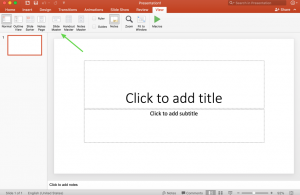
By setting up the Slide Master, you can maintain control of the deck’s design elements even if you grant other team members access to edit the presentation. This cuts out the hassle of importing colors, changing fonts or other tedious and unnecessary extra work. Ideally, your organization will set up one or two overarching PowerPoint themes with various slide layouts to be used consistently as templates throughout your organization. This will eliminate a lot of headaches and edit rounds as your business establishes and maintains its brand.
Editing the Slide Master
The Slide Master controls the theme, layout, background, colors, fonts, and positioning of all the different types of slides. By enabling you to create multiple layouts and designs for various use throughout your presentation, the Slide Master makes it easy to drop in content as you go.

In Slide Master View, the left preview panel will show one large slide (the Slide Master) with several smaller variants of slide layouts beneath it. These are commonly used layouts, which PowerPoint includes by default, but you can edit, add or remove them as needed from this view. Whatever you adjust on the larger slide will be automatically applied to the rest of the slides beneath it. It’s a great place to add slide numbers, dates, logos, headers, footers or anything you would like to include consistently across all slides.
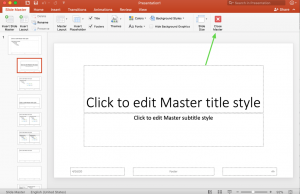

After you’ve made all your edits to the Slide Master, select “Close Master” to apply your changes and go back to the Normal presentation view. From there, you’ll be able to add new slides as needed by choosing from the various layouts you just created.
Selecting Fonts & Font Sizes
When it comes to font styles, it’s important to remember that your fonts need to be compatible across devices and operating systems to maintain design consistency — regardless of who opens the presentation. System fonts are not the same across all devices. If you choose a font that’s native to Mac users, for example, but not to Windows, then a Windows OS may replace your chosen font with another, somewhat similar font by default or worse: display a string of nonsensical characters and symbols instead. This can be super frustrating if you’ve dedicated the time toward designing a beautiful brand — only to have your work get lost and replaced along the way.
The key is to select fonts that are either basic, shared fonts like Arial, or to be sure to send font files along with the PowerPoint file to anyone who might open the presentation on their own device. Each user will need to download and install the custom font files before opening the PowerPoint file for the first time. Here’s more information on how to install fonts on a Mac and how to install fonts in Windows.
In addition to selecting the right typeface, it’s also important to make sure your font is the right size. To ensure legibility on all screen sizes, the best practice is to adjust headlines to size 32 or above and body copy to at least 24.
Inserting Charts, Tables & SmartArt
Once your theme, fonts, and colors have been set, you can begin setting up other important elements, such as diagrams, copy, and imagery. In terms of charts, tables, and SmartArt, our rule of thumb is “If you can make it in PowerPoint, you should.”
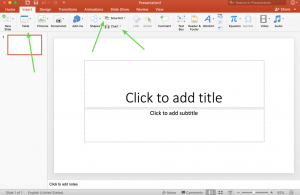
For example, if you want to include a diagram on a particular slide, you may be tempted to create it in Adobe Illustrator, Microsoft Excel or a different program, and then import to PowerPoint. Although you may have more flexibility and familiarity in other programs, you might also have team members who don’t work in those programs, leaving them unable to make any edits to those visuals as needed.
It’s also important to keep file size in mind. Importing images, even at smaller file sizes, will continue to increase the size of the PowerPoint file, which can make it difficult for certain users to open or send via email. Large file sizes will also increase load time, causing awkward delays during presentations.
Luckily, PowerPoint includes a variety of ways to set up native charts, tables, and SmartArt, so you can create diagrams that are easy to edit while keeping file size to a minimum.
Creating Simple, Beautiful PowerPoint Slides
When you’re ready to add images, text, transitions, and/or animations, keep simplicity and readability in mind. You may have the urge to make things as flashy as possible — but you should fight that urge. It’s important to keep your slides clean and easy to read on all screen sizes, from a smartphone or tablet to a desktop computer or conference room projection. The purpose of the presentation is to tell a story and provide fluidity between each slide. You’ll only confuse the audience if you have too much going on at once. Flesh out content onto multiple slides so the reader doesn’t lose interest.
Saving Multiple Versions & Backups
Finally, an obvious yet all-important tip is to save often as you go. Start by saving a clean version of the template once you’ve finished setting up the Slide Master, then create copies to save separately for each new presentation using that theme.
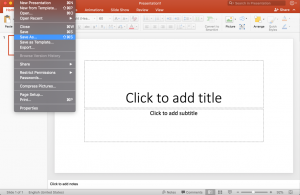
Corrupted PowerPoint files caused by system or user errors are not uncommon on Windows or Mac, so having a backup will save yourself the frustration of starting from scratch.
Whether you have a marketing team of ten or a lonely intern dedicated to designing a consistent look and feel, follow these simple tips to ensure your brand is consistent, beautiful, professional, and powerful throughout every presentation from your team.
Why Blogging Should Be an Important Part of Your Social Media StrategyBy Maggie Markert, Senior Strategist
In today’s digital world, it is no secret that social media is a must-have for businesses. A 2018 report from the University of Massachusetts Dartmouth found that an overwhelming majority of Fortune 500 companies agree that social media is extremely important, with:
- 98% of companies using LinkedIn
- 91% of companies using Twitter
- 89% of companies using Facebook
- 63% of companies using Instagram
What’s important to note about the use of social media among Fortune 500 companies is that they provide great insight into what trends we’ll likely see emerge among other companies. One of the trends that we’ve seen gain more traction in business – more than it has ever before – is blogging.
According to the report from the University of Massachusetts Dartmouth, corporate blogs are becoming increasingly more prevalent. In fact, as of 2018, 53% of Fortune 500 companies now have corporate blogs, including companies in insurance, banking, healthcare, financial data services, and more. This is an 11% increase from the prior year.
What’s Causing the Increased Emergence of Corporate Blogs?
In the past, for some companies, blogs were just another way to share their important news or other self-promotional content such as philanthropic initiatives. But, today, more and more companies are realizing the important benefits corporate blogs have for their businesses.
Two of the key benefits blogs provide are:
1. Improved SEO
Having and regularly maintaining a blog on your company’s website can provide an advantage when it comes to SEO. By using the right key words on your blog page on your website and throughout your blog posts, can boost your standing in search engines when individuals (potential prospects) look for specific information related to your area of work. Ultimately, if done the right way, blogging can help drive traffic to your website and covert leads for sales.
2. A Platform for Thought Leadership
A corporate blog is a great way to showcase the expertise and knowledge of your executive team and employees on particular topic areas related to the service or product your company provides. Whether it is reacting to a current event that could impact or have implications on your industry or explaining a certain topic (For instance, if you’re in financial services, this could be discussing the affect artificial intelligence could have), a corporate blog can be used to position your company, executives and employees as the experts on the topics that are most important to your business, customers and prospects. This also lends itself to SEO. The more you are regularly discussing topics that are in line with keywords customers and prospects are searching for on the internet, you could see an increase in website traffic and potentially leads.
Given the significant benefits corporate blogs can provide, companies should consider adding it to their overall social media strategy or improving their blog practices.
However, it is important to remember that for blogging to be successful and provide the benefits discussed earlier in this post, companies must:
- Dedicate a considerable amount of time and resources – primarily talent in marketing, social media, and writing – to the process for strategy, research and development.
- Be patient and give blogging a chance, as success won’t happen overnight.

